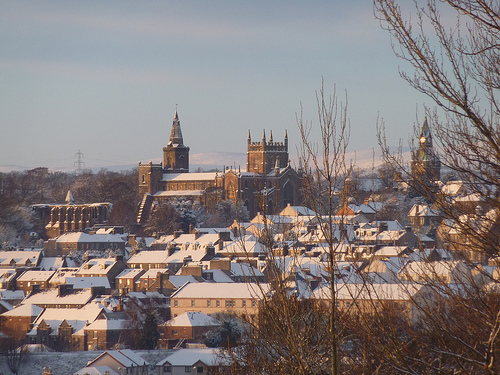Dunfermline
The town of Dunfermline is situated just north of the River Forth, on an area of land that was considered to be easily defensible by the ancient people that settled there. Translated from the old Garlic ‘Dun Fearam Linn’, the name of the town actually means ‘the Fort that sits in the bend of the stream’.
This is the place where King Malcolm III of Scotland wed Queen Margaret in 1070, and where they subsequently built a fortress. The site that they chose for their fortifications is believed to be on the site where the earlier Pict inhabitants had located their defences. Take a walk into Pittencrieff Park to visit the original fortifications that once guarded the town. Known officially as “Malcom Canmore’s Tower”, they are definitely worth checking out!

Rather than the town growing under the guardianship of Malcolm, it was instead down to Queen Margaret’s interventions that the town grew into a strong and thriving settlement, as it was she who saw to the founding of a Benedictine Priory in the town…
Dunfermline Abbey
The Priory was built upon orders from Margaret’s son, King David I, and became known as Dunfermline Abbey. During the 1500’s, it was partially converted to function as both an abbey and a palace. With the abbey firmly in place, the town continued to grow. It was due to the fact that the abbey was in part being used as a royal residence, that it withstood the onslaught of the reformation, as Anne of Denmark, who was the wife of James VI, was living there.
More than a thousand people lived in the town of Dunfermline by 1624, but following a major fire which swept through the town, many of these people were left homeless. The Abbot’s House was one of the few buildings that remained standing following the fire – the building dates back to the 1400’s and has undergone building work throughout the following centuries. It is now the Abbot’s House Heritage Centre and is well worth a visit if you are in town.
Development of Dunfermline
During the Industrial Revolution, Dunfermline was at the heart of the linen industry, and by the 19th century there were five coal mines operating around the town. During the 1900’s the major employer in the town was the military as people were drawn into the naval bases situated on the northern side of the river. The town has borne a famous son, though his name will recognised more in the US than it is over here in the UK. William Carnegie was a Dunfermline man, who, with his son Andrew, emigrated to America. Andrew went on to found a steel making empire that grew to make him the world’s richest man. Carnegie never forgot his home town though and founded a library here, the first of three thousand that were to bear the Carnegie Name. The place of his birth, just south of the Abbey is now a museum.
Other Attractions
One of the most visited attractions in the town is St Margaret’s Cave. Located beneath a modern car-park, the cave is believed to have been visited by Margaret after she wed King Malcolm and came here to pray. It remains a place of pilgrimage for the faithful today.
Kids will love Deep Sea World, Dunfermline’s aquarium, especially if given the chance to undertake the underwater safari. Adults will love the opportunity to dive with sharks and stingrays and kids over eight can also get in on the action if they are brave enough. Tickets can be booked prior to visiting to ensure you get maximum fun from your day out.
Other attractions in the town including a gliding centre, a fisheries museum, a secret bunker and a golf club.


